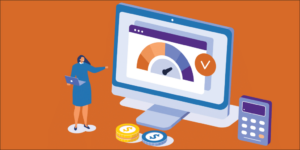Running your own small business often represents a long-held dream. But a business is still a business — and that means your dream should include making money. Along with your blood, sweat and tears, making sure your business is financially successful takes a lot of planning and number crunching. A business budget combines both, and it’s one of the most important tools you can use as a small business owner.
Why Budgets Are Important
Your business budget literally shows you the money — the amount the business has on hand, its expenses and what it’s bringing in. An effective budget accurately records the business’ inflows and outflows of cash in the past and in the present, and it helps you plan how to shape those cash flows for the future by estimating future revenue. Besides its essential role in your business planning and operations, your budget can also be of interest to potential investors or financial institutions when you are applying for funding.
Create a Business Budget: Getting Started
When you create a budget, you express in numbers how you want your business to perform in the future. So it’s important to know what your goals are for the business — and to do the research necessary to make sure those goals are realistic. As time goes on, you can see how the actual numbers match up with your targets and use this data to plan for the future. Keep in mind that a budget is generally an educated guess.
Your inflows and outflows will rarely match up exactly with your projections, and that’s OK. The key is to get as close as you can using the most relevant and accurate data available. Make sure to list all your business expenses, even the smallest ones, to ensure no money slips through the cracks. You can create a budget on your own, with the help of an accountant, using financial software or utilizing spreadsheet templates, depending on the complexity of your business and your comfort level. Whatever form your budget takes should make sense for you and the unique needs of your business.
Short-Range and Long-Range Business Budgets
The main financial budget you’ll be working with should cover a whole year, usually divided into months. Most budgets will need to be adjusted throughout the year as data comes in. You may also want to create a cash-flow budget to help you keep track of cash on hand. This will be fairly short-term, updated on a daily to monthly basis. A long-range budget will cover at least three years (and perhaps up to five), and it is divided into quarters or even years. The short-term budget can be used to update this as needed.
Separating Business Finances from Personal Finances
Separating business finances from personal finances is a crucial step in creating a business budget. This separation helps small business owners treat their business as an independent entity, making it easier to manage finances and make informed decisions. Here are some reasons why separating business finances from personal finances is essential:
- Avoids commingling of funds: When business and personal finances are mixed, it can lead to confusion and make it challenging to track business expenses. Separating finances helps to avoid commingling of funds and ensures that business expenses are accurately recorded.
- Simplifies tax preparation: Separating business finances from personal finances makes it easier to prepare tax returns. Business expenses can be easily identified and claimed as deductions, reducing the risk of errors or missed deductions.
- Improves financial management: Separating finances helps small business owners manage their business finances more effectively. It enables them to track income and expenses, identify areas for cost reduction, and make informed decisions about investments and funding.
- Enhances credibility: Separating business finances from personal finances demonstrates a level of professionalism and credibility. It shows that the business is being run in a structured and organized manner, which can help build trust with customers, suppliers, and investors.
To separate business finances from personal finances, small business owners can take the following steps:
- Open a business bank account: Open a separate business bank account to keep business finances separate from personal finances.
- Obtain a business credit card: Obtain a business credit card to use for business expenses, rather than using a personal credit card.
- Set up an accounting system: Set up an accounting system, such as QuickBooks, to track business income and expenses.
- Establish a budget: Establish a budget that outlines projected income and expenses, and regularly review and update it.
By separating business finances from personal finances, small business owners can improve their financial management, simplify tax preparation, and enhance their credibility.
Creating a Business Budget: What to Include
Your budget will include a number of components that together show how much money is coming into the business, how much is going out and what is left over. Setting spending goals and wisely spending money significantly impacts your business’s success by ensuring funds are allocated to beneficial areas while avoiding unnecessary expenses.
Revenues
Revenues are all the money that comes into a company. This can consist of sales (the money your company earns from customers through the sale of goods or services) or other sources of income, including:
- Royalties
- Fees
- Donations
- Payments from trademarks and patents
- Dividends
- Sale of property
- Rental of real estate or property
For your budget, it’s crucial to estimate your revenues as accurately as you can. This can be tricky, especially when forecasting sales. Use the previous year’s sales as a guide, or if you are a new business, make sure to do your research so you have a realistic idea of how much you’ll be able to bring in. When in doubt, it’s best to err on the conservative side in your revenue projections. Your revenues will determine the numbers for the rest of your budget: Your planned expenses will have to be less than what you bring in, and the difference between your revenues and expenses will determine your profit.
Unexpected Costs
It’s important to try to be as accurate as you can when planning your spending, but it’s also wise to build some slack into your budget in case expenses are higher than you anticipate. While a budget itself won’t generate more money, it is essential for analyzing costs and strategically planning to increase revenue and profit. You can divide your costs into different categories:
- Fixed costs are expenses that are always the same amount, including items such as rent, insurance, internet service, etc.
- Variable costs are usually core business spending, such as inventory, raw materials and freight. These costs will increase or decrease depending on your sales.
- Semi-variable costs are fixed costs, such as utilities, telecommunications and salaries, that may fluctuate depending on the needs of the business.
- One-time expenses, such as the purchase of equipment, should also be included in your budget.
Don’t forget to include business income taxes in your costs! Your revenue and expense projections can help you estimate how much you should owe in taxes.
Profits
Profits are what is left over when you subtract your costs from your revenues. More than that, they are the reason you have a business in the first place. Knowing how much profit you want to make is a crucial step in the budget planning process.
Different industries typically have different profit margins, so, again, do your homework to find out what profit levels are realistic for your business. Since profits are a combination of revenues and expenses, either can be adjusted to reach your profit goals. This might mean ramping up sales or cutting costs (or both) to get your profits where you want them. You also need to think about what you want to do with your profits. Will you pay yourself, invest in the business, save or reward employees? This should also be reflected in your budget.
Cash Flow
Cash flow measures the financial inflows and outflows of your business within a certain period of time. It’s a measure of how much cash you have on hand at any given time. Cash flow planning can actually make or break your business, quite simply because you need cash to run your company. If you’ve got salaries to pay and inventory to buy, you always need enough cash on hand to do that. Cash flow planning is all about timing.
It measures whether the revenues coming in over the period of a week, month, or quarter is enough to pay for all the expenses you will have during that time. Many small businesses must pay in cash but get paid on credit, which can cause cash flow problems when they have immediate expenses and must to wait to get paid themselves. The cash flow budget can show in advance where these problem areas might occur, giving you time to find a solution first. Your cash flow budget will usually be separate from your main financial budget, but they will be closely linked. Cash flow budgets can be daily, weekly or monthly depending on the needs of your business.
Step-by-Step Business Budget Creation Process
Creating a business budget is a straightforward process that involves several steps. Here’s a step-by-step guide to creating a business budget:
- Identify revenue streams: Identify all sources of revenue, including sales, services, and investments.
- List expense categories: List all business expense categories, including fixed costs, variable costs, and one-time expenses.
- Estimate revenue: Estimate revenue for each revenue stream, based on historical data and market trends.
- Estimate expenses: Estimate expenses for each expense category, based on historical data and market trends.
- Create a budget template: Create a budget template that outlines projected income and expenses.
- Review and update: Regularly review and update the budget to ensure it remains accurate and relevant.
By following these steps, small business owners can create a comprehensive business budget that helps them manage their finances effectively.
Examine Your Revenue and List Expense Categories
Examining revenue and listing expense categories are critical steps in creating a business budget. Here’s how to do it:
- Revenue streams: Identify all sources of revenue, including sales, services, and investments. Consider the following:
- Sales: Revenue generated from the sale of products or services.
- Services: Revenue generated from providing services, such as consulting or freelancing.
- Investments: Revenue generated from investments, such as rental properties or stocks.
- Expense categories: List all business expense categories, including fixed costs, variable costs, and one-time expenses. Consider the following:
- Fixed costs: Expenses that remain the same from month to month, such as rent or salaries.
- Variable costs: Expenses that vary from month to month, such as utilities or supplies.
- One-time expenses: Expenses that are incurred only once, such as equipment purchases or software licenses.
By examining revenue and listing expense categories, small business owners can gain a better understanding of their business finances and create a more accurate budget.
Subtract Fixed Costs and Variable Expenses
Subtracting fixed costs and variable expenses from revenue is a critical step in creating a business budget. Here’s how to do it:
- Fixed costs: Subtract fixed costs from revenue to determine the amount of money available for variable expenses and profit.
- Variable expenses: Subtract variable expenses from the remaining revenue to determine the amount of money available for profit.
By subtracting fixed costs and variable expenses from revenue, small business owners can determine their net income and make informed decisions about investments and funding.
Set Aside a Contingency Fund for Unexpected Costs
Setting aside a contingency fund for unexpected costs is an essential step in creating a business budget. Here’s why:
- Unexpected expenses: Unexpected expenses can arise at any time, such as equipment failures or natural disasters.
- Cash flow: A contingency fund helps to ensure that the business has sufficient cash flow to cover unexpected expenses.
- Financial stability: A contingency fund helps to maintain financial stability and reduce the risk of financial distress.
To set aside a contingency fund, small business owners can consider the following:
- Emergency fund: Set aside 3-6 months’ worth of expenses in an easily accessible savings account.
- Line of credit: Establish a line of credit with a bank or other financial institution to provide access to funds in case of an emergency.
- Insurance: Consider purchasing insurance to protect against unexpected expenses, such as liability insurance or business interruption insurance.
By setting aside a contingency fund, small business owners can ensure that their business is prepared for unexpected expenses and maintain financial stability.
Business Budgeting: Fail to Plan or Plan to Fail
A budget is an indispensable tool for any small business. It maps out in detail the direction of the business and all financial transactions that go into its operation. When prepared correctly, your budget allows you to set lofty goals, see the reality of your business, learn from any mistakes and adjust accordingly. A successful budget is a crucial part of a successful business!



























